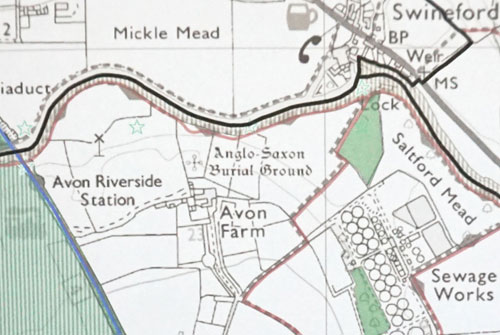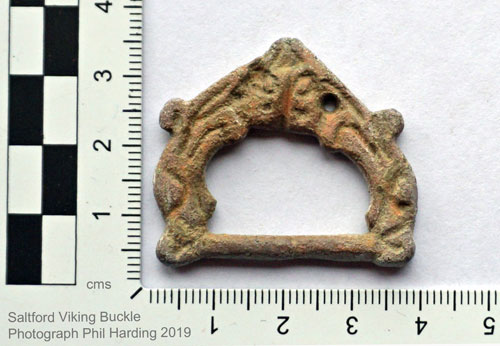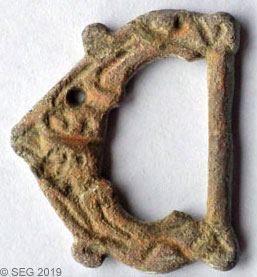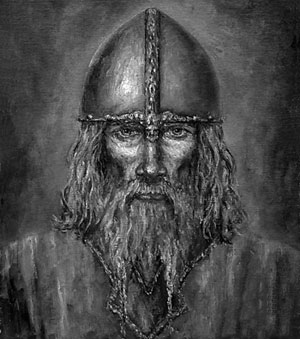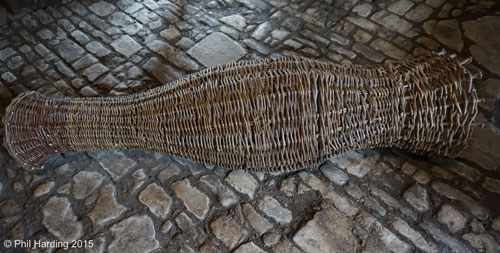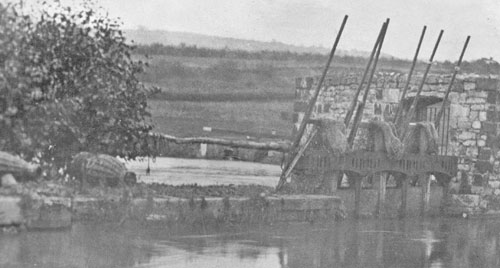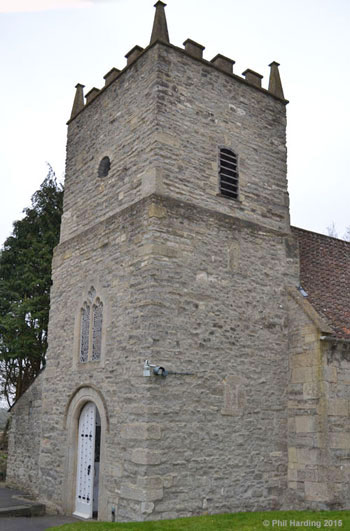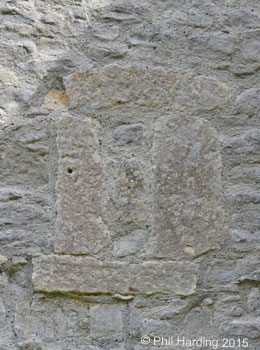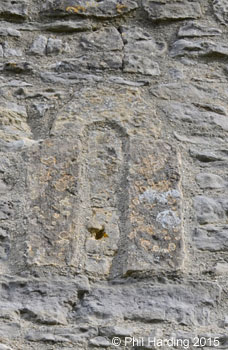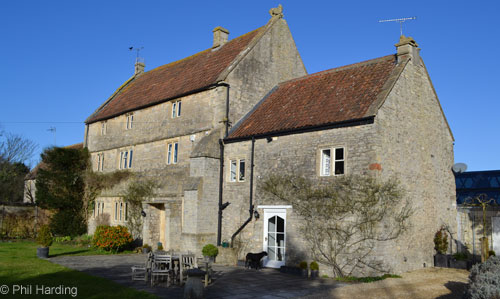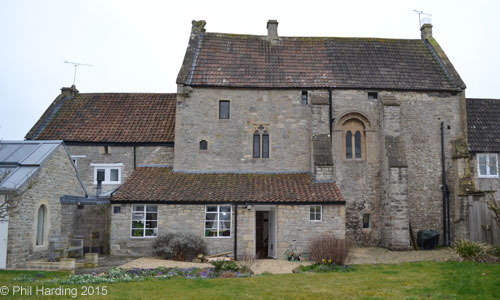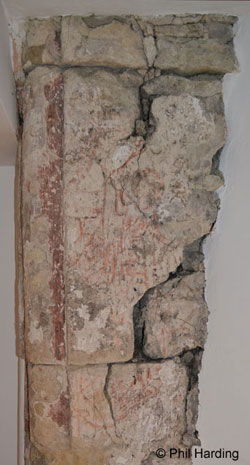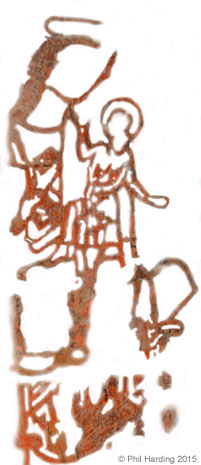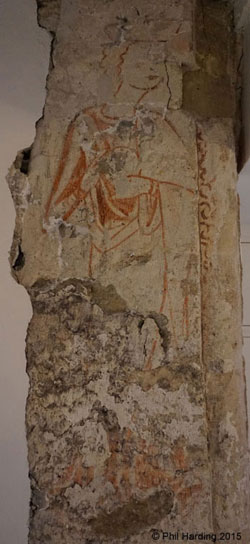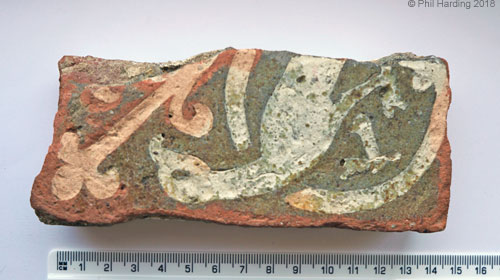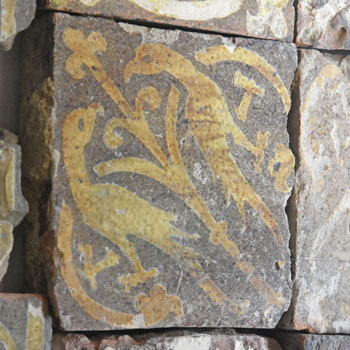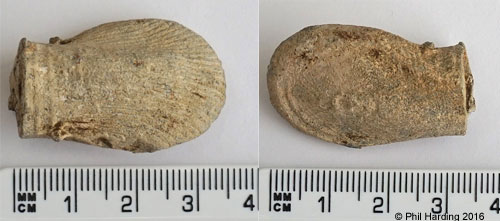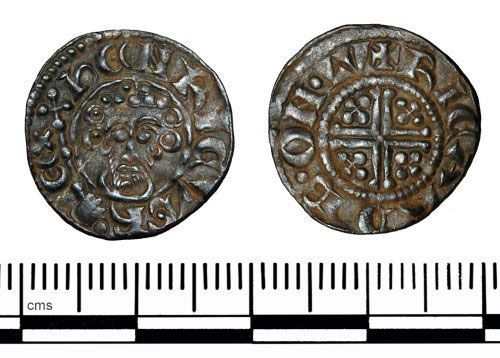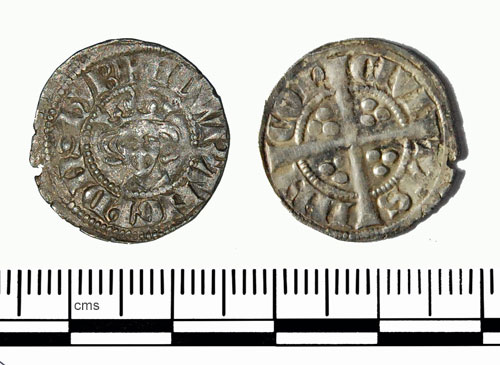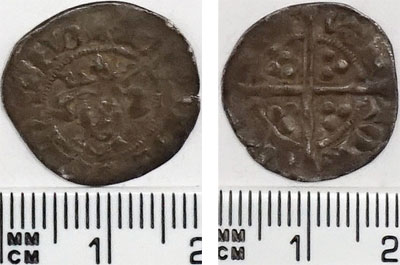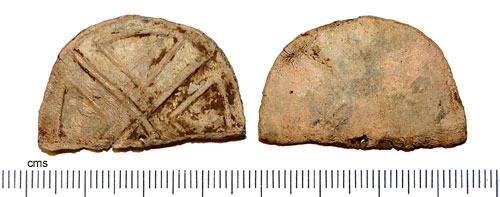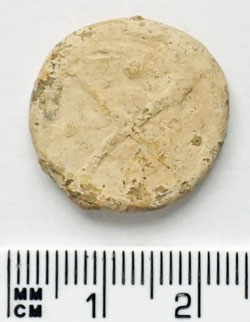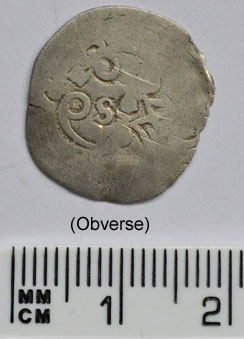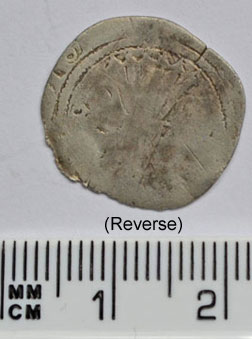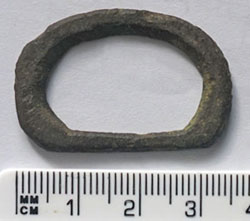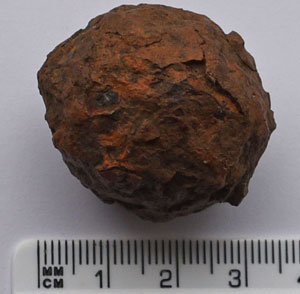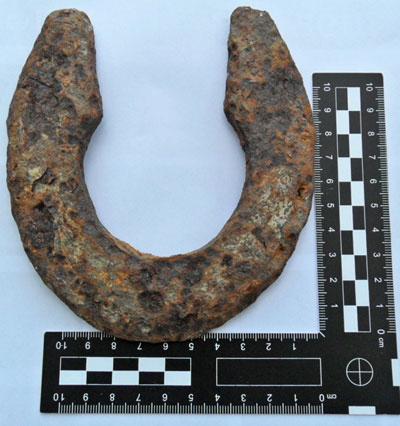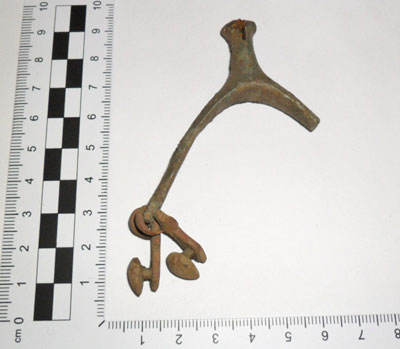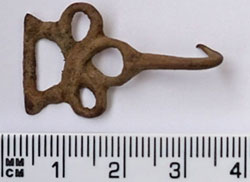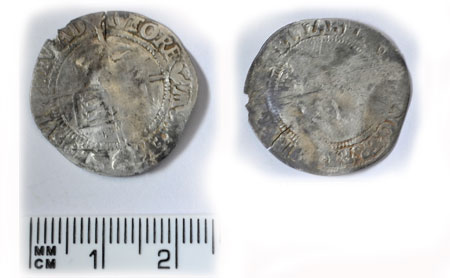|
Saltford Environment Group
|

The 1148 Norman Window at Saltford Manor
|
SEG Home > History of Saltford > A - Z > Online Museum > 5th - 16th Century The History of Saltford: ONLINE MUSEUM5th - 16th CenturyScroll down the page to see Saltford's past including the following special features on this page:- There are also Saltford artefacts from the Tudor period (1485-1603) on this page. 5th - 13th CenturiesAnglo-Saxon Burial Ground (410 to 1065 AD)
The Anglo-Saxons inhabited Great Britain from the 5th century. They included people from Germanic tribes who migrated to Great Britain from continental Europe, their descendants and members of the indigenous British population who adopted some aspects of Anglo-Saxon culture and language. An Anglo-Saxon Burial Ground was discovered in c.1936 on the northern edge of the parish, between the River Avon and Avon Farm. Six inhumations (graves) with an Anglo-Saxon iron knife were found in a gravel pit at this location. The graves within the pit lay approximately east and west. The site of this gravel pit, now filled in, was referenced by the farmer F J Tyley, of Avon Farm. The knife was in the University of Bristol Museum but unfortunately destroyed by bombing during World War II. Acknowledgements/Information Sources
Viking Buckle (1,000 - 1,100)
This bronze 11th Century Viking Buckle (length 33mm, width 38mm, thickness 4mm) was found on the north side of Saltford in 2018, quite close to St Mary's church. Described as a very rare find for this area by the Gloucestershire and Avon Finds Liaison Officer, it is classified by the British Museum as a "Find of note and of Regional Importance".
The following is from its official description on the Portable Antiquities Scheme website (https://finds.org.uk):- Copper alloy D-shape buckle that has a complex moulded frame. The front of the buckle is expanded to form a sub-triangular panel that has a moulded animal head on the top with hollowed circular ears, lentoid eyes below and a triangular snout forming the forward edge. Flanking this and forming the curving sides of the buckle is an arching beast on each side that face back towards the strap bar. The neck of each beast emanates from the side of the first facemask and is decorated with two recessed lines that run halfway down its length to the head. Behind the head and on the outside edge of the frame is a curving projection that forms the ear of the beast. The face is decorated with large lentoid eyes, line below for the mouth and long snout with a recessed bulbous terminal for the nostril. Below the snout in the narrowed strap bar that is gripped in the mouth of both the side beasts. This buckle is in the ringerike* style, a similar example, found in London from the Thames, was dated to the 11th century (Wilson, 1964, 143-144). *Note by SEG: Quite how this remarkable 1,000 year-old artefact got to Saltford is difficult to know but you can read more on our special feature page >> See our feature page on The Saltford Viking Buckle >> - includes information about the Vikings in this area. Perhaps Sweyn Forkbeard was the reason why the Viking Buckle arrived in Salford...
Acknowledgements/Information sources:
The Mill at Saltford and Eel Trap (used since the 10th/11th Centuries)
Eel traps were used at Saltford Brass Mill since the 10th/11th Centuries. At that time the mill would have been a corn mill housed in a simple wooden structure of which nothing is known. In later centuries fulling, the thickening process of hand-woven woollen cloth was carried out in buildings which would have been far more substantial. Eel traps were placed in the Head Race (where water is channelled from the weir to the water wheel sluice). The trap photographed here (in 2015) is on the floor of Saltford Brass Mill. The exposed stone floor shown here is the "working floor" used in the 1750s.
This photograph from c.1900 shows eel trap baskets and fishing nets etc. at Saltford Brass Mill Island. c.1000 - 1060s: Lower tower for St Mary's Church
The base of St Mary's Church tower is thought by architectural historians to be late Anglo-Saxon (pre-Norman conquest). It is almost certainly Saltford's oldest surviving built structure. There may have been another building with the tower and we cannot know for sure if it was originally constructed as a place of worship or for other purposes. The tower was subsequently extended upwards and any other attached building replaced by the Norman church building thereafter.
For more information about St Mary's Church in Saltford click here: St Mary's >> 1086 - Saltford ("Sanford") recorded in Domesday Book
The earliest documentary record we have for the existence of a settlement at Saltford is in the 1086 Great Domesday Book (as "Sanford"). For background information, translation and intepretation click here: Domesday Book - Saltford >> c.1148: Saltford Manor House
Saltford Manor, a Grade II listed building of Norman origin, is thought to be the oldest continuously occupied private house in England. It was previously known as Manor Farm and, for example in the 1861 Census, Court House Farm. The house was built in c.1148 on the estate then owned by the Earls of Gloucester and previously owned by Geoffrey de Montbray, the Bishop of Coutances (Normandy) and is thought to have been associated with Keynsham Abbey. The Norman window (1148) at the rear of the property has some similarities to Hereford Cathedral built at the same time, in particular a Norman arch etched with diamond markings that are similar to features in the Cathedral. Records do not exist for the complete line of ownership for Saltford Manor/Salford Manor Farm. It is believed that originally there was an Anglo Saxon wooden structure on the site of Saltford Manor House. It is possible that there may have been a Roman Villa or similar on this site before then. You can see and read more about Saltford Manor from this link: Saltford Manor >> Early 1200s - Wall Paintings at Saltford ManorThe Early Medieval Wall Paintings on the first floor of Saltford Manor House are believed to be early 13th Century and possibly the oldest domestic wall paintings in England. Here we have provided photographs of the two revealed wall paintings and, to help you identify the images they depict, we have created an enhanced version where the original 13th Century red paint has been isolated from the damaged plaster. This reveal of the images that comprise the two paintings has never been attempted before.
You can see and read more about Saltford Manor (built c.1148) and the paintings from this link: Saltford Manor >> 1166 Keynsham Abbey Floor Tile (fragment)
Ref. SHC 023 This fragment of a floor tile depicting a bird was found in a spoil heap at the Keynsham Abbey site by Saltford resident David Cox in the 1960s. Below is a photograph of a complete floor tile of similar design also from Keynsham Abbey displayed at Keynsham Library (photographed in 2018).
Keynsham Abbey was a monastic abbey founded c. 1166 by William, Earl of Gloucester. At that time Saltford also came under the Honour of Gloucester. The Honour of Gloucester was one of the largest of the medieval English feudal baronies. Feudal baronies are largely thought to have been brought into existence by the early Norman kings of England after the Norman invasion of 1066. The manor (land area) of Saltford was one of many landholdings that were originally annexed to the Honour of Gloucester; but the date that this occurred is not known, possibly in 1122 when the first Earl of Gloucester was created, or soon after. The stone building that is now Saltford Manor House was built in c.1148, c.18 years before Keynsham Abbey. As Keynsham Abbey was such a large structure, locals living in Saltford at that medieval time would have almost certainly been well aware of this major building undergoing construction. It would be fascinating to know if Saltford residents were employed as labourers to assist with the Abbey's construction and if the priest living in Saltford Manor House in the early 13th Century and the Abbot at Keynsham Abbey met and knew each other. Keynsham Abbey was an Augustinian Abbey and operated until the dissolution of the monasteries under Henry VIII's rule in 1539. The dissolution led to a significant re-distribution of land holdings in Keynsham and Saltford. The last remaining ruins of the Abbey are located in today's Keynsham Memorial Park. Acknowledgements/Information sources:
Pilgrim's Lead Ampulla (c.1175 - c.1500)
Ref. SHC 007 This medieval ampulla featuring a scallop shell was discovered in December 2015 on the Saltford/Keynsham boundary, due west of Grange Road. A lead pilgrim's ampulla is a miniature vessel (phial) used to hold holy water dispensed to pilgrims at holy shrines. These mass produced items were also pilgrimage souvenirs giving pilgrims an outward display of proof of travel, experience or affiliation when worn around the neck on a cord or chain as a pendant. Scallop shells were also commonly used as the design motif for pilgrim badges and featured as the design for some ampullae. Coming into use in the last quarter of the twelfth century, ampullae were, in England, almost the only kind of pilgrim souvenir to be had during the 13C. They were available at a number of shrines and having been brought back by returning pilgrims, or sold by entrepreneurs, probably featured as secondary relics in many 13C English parish churches. The scallop shell, in different shapes and sizes, has long been the symbol of the Camino de Santiago - the name of any of the pilgrimage routes to the shrine of the apostle St. James in the Cathedral of Santiago de Compostela in Galicia in NW Spain. Scallop shell artwork can be seen (2016) on the internal walls of the cathedral. There appears to be a crowned reverse 'S' with a cross-hatched background on the other side of the ampulla and an alternative theory is that the ampulla might be associated with the 'Our Lady of Sudbury' medieval shrine in Suffolk. If that is the case, this would date the ampulla from c.1350 - c.1500. This ancient shrine was situated in the chapel of Our Lady and St Anne which adjoined the porch of Simon of Sudbury's Collegiate Church of St Gregory; records of the shrine are scant and such shrines were removed from churches under instructions from Henry VIII issued in 1538. BACKGROUND TO MEDIEVAL PILGRIM JOURNEYS TO & FROM THE LOCAL AREA This unusual relic gives a fascinating glimpse into the past history of the local area and illustrates just how widely travelled some people were all those years ago at a time when England was Roman Catholic. In medieval times the journey from Bristol to Santiago (NW Spain) was a popular pilgrimage route. Also St Anne's Well (a healing well) and the chapel of St. Anne in the Wood, at Brislington, were an important and popular medieval pilgrimage destination - as popular then as Canterbury and Walsingham. Although records from that period are scant and the chapel itself has long since disappeared, it is thought that the chapel was owned and run by Keynsham Abbey. The Abbey was operational until the dissolution of the monasteries in 1539. Perhaps a pilgrim returning to Saltford over 700 years ago on his way back either from Spain via Bristol or from Brislington was riding his horse or walking across the fields, the cord/chain holding the ampulla broke and he lost it or he was set upon by thieves and during the ensuing scuffle the ampulla was lost. There could of course be any number of explanations for how it arrived on the borders of Saltford and Keynsham. Acknowledgements/Information sources:
1205-1207 King John silver penny
This King John silver penny in "extremely fine" condition and struck or hammered in London between c.1205 and c.1207 was found in Saltford in 2014/15. Obverse description: Bust facing forwards holding sceptre. Obverse inscription: HENRICVS R.EX (pellet on S, round-topped Rs). Reverse description: Short cross voided with four pellets in each angle. Reverse inscription: RICARD B ON LV (flat-topped Rs) Acknowledgements/Information Sources
1280-1281 Edward I silver penny
This Edward I silver penny slightly worn in "very fine" condition and struck or hammered in Lincoln in 1280-81 was found in Saltford in 2015. Obverse description: Crowned bust facing forwards, trifoliate crown. Obverse inscription: EDW R ANGL DND HYB. Reverse description: Long cross with three pellets in each angle. Reverse inscription: CIVITAS LINCOL Acknowledgements/Information Sources
14th - 16th Century1317-1320 Edward II silver penny
Ref. SHC 015 Edward II silver penny, type 14, Mint of Canterbury, 1317-20. Found in Beech Road in the 1950s by Mr E B (Bert) Cox whilst digging his garden. Obverse description: Crowned facing bust. Obverse inscription: EDWAR R ANGL DNS hYB Reverse description: Long cross with three pellets in each angle. Reverse inscription: CIVI TAS CAN TOR SEG has photographed the coin (the image you see) and the British Museum has used our information and photographs to authenticate and log the coin on its Portable Antiquities Scheme online database: artefact link. 1350 to 1800 Gaming Token (lead)
Description: Circular lead token 35mm wide. On the obverse is a cross with a triangle in each corner, the reverse is undecorated. The item was bent in two and then snapped, resulting in the loss of about 40% of the artefact. Although similar in style to medieval coins, this style of token dates from the Medieval to Post Medieval Period 1350-1800. Acknowledgements/Information Sources
15th - 17th Century Gaming Token (lead)
Ref. SHC 009 Description: Circular lead token 20mm wide. On the obverse is a cross with 4 raised dots, reverse is undecorated. 1469-1504 Silver Spanish Real
This silver Spanish Real ('Royal') was found SE of Avon Farm on the north side of Saltford in 2014. It was struck in Spain by King Ferdinand V (of Aragon) and Queen Isabella I (of Castile). On the obverse is, it is thought, the Yoke of Aragon, and on the reverse the 'Arrows of Castile' can just be seen on this very worn coin. After the Spanish kingdoms were united under Ferdinand and Isabella and soon after the conquest of Granada, the Spanish monetary system was reformed. In 1497 the 'Real' was made the standard silver coin for the Spanish Kingdom. It is noteworthy however that this coin found in Saltford dates to the period of Christopher Columbus when he was commissioned and supported by Ferdinand and Isabella on his four round-trip voyages between 1492 and 1503 that marked the beginning of the European exploration and colonisation of the American continents. Acknowledgements/Information Sources
15th or 16th Century Buckle
Ref. SHC 008 The design of this bronze buckle suggests it came from the late medieval period. Acknowledgements/Information Sources
15th or 16th Century Grapeshot
Ref. SHC 017 This heavily corroded cast iron grapeshot was found on the north side of Saltford in 2017. It is likely to have been from the late 15th or 16th Century (during the Tudor period). Grapeshot like this would have been fired from a small cannon. Acknowledgements/Information Sources
16th Century (approx.) Keyhole Horseshoe & Spur
Acknowledgements/Information Sources
16th Century Tudor Dress Hook
Ref. SHC 010 This 16th Century (Tudor period) bronze dress hook was found on the north side of Saltford in 2015. Acknowledgements/Information Sources
Elizabeth I (1558-1603) silver coin
This Elizabeth I coin (possibly a silver threepence) was found SE of Avon Farm on the north side of Saltford in 2014. Acknowledgements/Information Sources
See next page for 17th Century >> © Saltford Environment Group
|
This Page:-Next Pages:-Previous page:-Also see:- |

